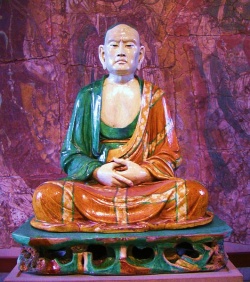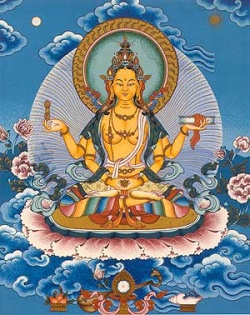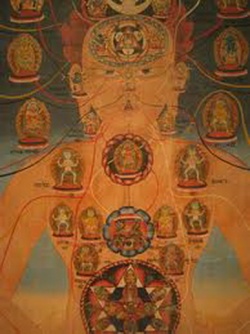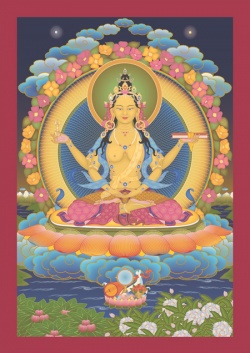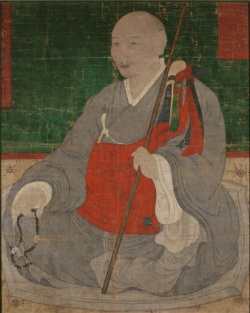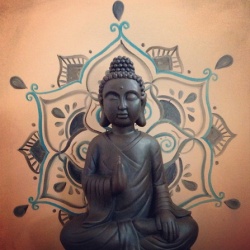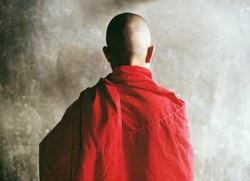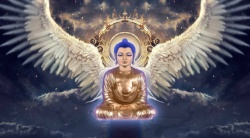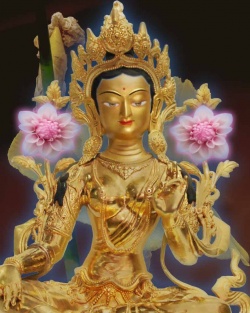Arhat
An Arhat (Sanskrit: अर्हत arhat; Pali: Arahant), in Buddhism, is a spiritual practitioner (Monk or layperson) who is liberated and has attained Nirvana.
A range of views on the attainment of Arhats existed in the early Buddhist schools.
The Sarvāstivāda, Kāśyapīya, Mahāsāṃghika, Ekavyāvahārika, Lokottaravāda, Bahuśrutīyas, Prajñaptivāda, and Caitika schools all regarded Arhats as being imperfect in their attainments compared to Buddhas.
The Pali Tipitaka, the earliest of the remaining complete Buddhist canons of scripture, portrays the arhat as the final product of The Buddha's path to liberation and the goal to which all disciples aspired.
The Mahayana was motivated by a more altruistic ideal in which spiritual practitioners while making efforts towards their own liberation were moved by compassion towards their fellow man and committed to helping them discover the path to liberation too.
The Mahīśāsaka and the Theravāda regarded Arhats and Buddhas as being more similar to one another. The 5th century Theravadin commentator Buddhaghosa regarded Arhats as having completed the path to Enlightenment.
Etymology
The exact interpretation and etymology of words such as Arahant and arhat remains disputed. In the Theravada tradition, and in early PTS publications, the word Arahant or arhat is interpreted to mean the "worthy one".
This has been challenged by more recent research, resulting from the etymological comparison of Pali and early Jain Prakrit forms (arihanta and arahanta). The alternative etymology is "foe-destroyer" or "vanquisher of enemies," which corresponds to the Jain definition.
The latter challenges the assumption that the root of the word is Pali araha (cf. Sk. arha);
Richard Gombrich has proposed an etymology of ari + hanta, bringing the root meaning closer to Jina (an epithet commonly used of both the leaders of the Jain religion and Buddha).
The term arhat was translated into East Asian languages phonetically as a transliterated term, exemplified in the Chinese āluóhàn (Ch. 阿羅漢), often shortened to simply luóhàn (Ch. 羅漢). However, the Tibetan term for arhat was translated by meaning from Sanskrit.
This translation, dgra bcom pa, means "one who has destroyed the foes of afflictions." This Tibetan translation of the meaning conforms with the Jain definition as well.
Arhat occurs as arhattā in the Rigveda and as the first offer of salutation in the main Jain prayer, the Namokar Mantra .
Based on a possible Sanskrit etymology, Arhant can be translated as deathless since "hant" in Sanskrit means death or killing and "ar" is often used for negation, implying "cannot be killed" or "beyond death" or "deathless".
This fits well with the central philosophical thought in buddhism, namely, "by realizing the true nature of phenomenological existence we transcend the cycle of life and death and become deathless in spiritual sense."
A similar transcendental spiritual state of being is referred to in the highly regarded Mahamrityunjaya Mantra , which also occurs in Rigveda and often called by sages as the heart of the Vedas.
The latter word occurs mostly in Buddhist and Jain texts, but also in some Vaishnava works such as the Bhagavata Purana. Arhattā also occurs in the Vaishnava Srī Narada Pañcaratnam.
In the early Buddhist schools
According to tradition, many disciples of The Buddha became Arhats in his lifetime. These included Sariputta, Upali, Maudgalyayana, Mahakasyapa, Katyayana, Khema and Uppalavanna.
In pre-Buddhist India the term arhat, denoting a saintly person in general, was closely associated with these two qualities, miraculous Power and asceticism.
The Buddhist drew a sharp distinction between their Arhat and Indian holy men in general, in Buddhism these miraculous powers were no longer central to arhat identity or to his mission.
A range of views on the relative perfection of Arhats existed amongst the early Buddhist schools.
In general, the Mahāsāṃghika branch, such as the Ekavyāvahārikas, Lokottaravādins, Bahuśrutīyas, Prajñaptivādins, and Caitika schools, advocated the transcendental and supermundane nature of the Buddhas and bodhisattvas, and the fallibility of Arhats.
The Caitikas, for example, advocated the ideal of the Bodhisattva (bodhisattvayāna) over that of the arhat (śrāvakayāna), and they viewed Arhats as being fallible and still subject to ignorance.
According to A.K. Warder, the Sarvāstivādins held the same position as the Mahāsāṃghika branch regarding Arhats, considering them to be imperfect and fallible.
The Kāśyapīya school also held the doctrine that Arhats were fallible and imperfect, similar to the view of the Sarvāstivādins and the various Mahāsāṃghika sects.
The Kāśyapīyas believed that Arhats have not fully eliminated desires, that their "perfection" is incomplete, and that it is possible for them to relapse.
In Theravāda Buddhism
In Theravada Buddhism, it means anyone who has attained Nirvana, including The Buddha himself. In the liturgy of Theravada Buddhism used in monasteries throughout the world the following words are recited daily:
- (Homage to him, the Blessed One, the liberated, the fully enlightened).
The Arahant is a person who has eliminated all the unwholesome roots which underlie the Fetters – who upon decease will not be reborn in any world, since the bonds (Fetters) that bind a person to the Samsara have been finally disolved.
In the Pali Canon, the word is sometimes used as a synonym for Tathagata.
After attainment of Nibbana, the five aggregates (physical forms, feelings/sensations, perception, mental formations and consciousness) will continue to function, sustained by physical bodily vitality.
This attainment is termed the Nibbana element with a residue remaining.
But once the Arahant pass-away and with the disintegration of the physical body, the five aggregates will cease to function, hence ending all traces of existence in the phenomenal world and thus total release from the misery of Samsara.
It would then be termed the Nibbana element without residue remaining.
Parinibbana occurs at the death of an Arahant.
In Theravada Buddhism The Buddha himself is first identified as an Arahant, as are his enlightened followers, because they are free from all defilements, without greed, hatred, delusion, ignorance and craving, lacking "assets" which will lead to future birth, the Arahant knows and sees the real here and now.
This virtue shows stainless purity, true worth, and the accomplishment of the end, Nibbana.
In the Pali canon, Ānanda states that he knows monastics to achieve Nibbana in one of four ways:
- one develops insight preceded by serenity (Pali: Samatha-pubbaṇgamaṃ vipassanaṃ),
- one develops serenity preceded by insight (vipassanā-pubbaṇgamaṃ Samathaṃ),
- one develops serenity and insight in a stepwise fashion (Samatha-vipassanaṃ yuganaddhaṃ),
- one's mind becomes seized by excitation about the Dhamma and, as a consequence, develops serenity and abandons the Fetters (Dhamma-Uddhacca-viggahitaṃ mānasaṃ hoti).
In Theravada, although the Arahants have achieved the same goals as The Buddha, there are some differences among Arahants due to the way of their practice.
In the Pali Canon, the word "Tathagata" is sometimes used as a synonym for Arahant, though the former usually refers to The Buddha alone.
These three awakened beings are classified as Arahant:
- Samyaksambuddha, usually just called Buddha, who discovers the truth by himself and teaches the path to awakening to others.
- Pratyekabuddha, who discovers the truth by himself but lacks the skill to teach others.
- Sravakabuddha, who receive the truth directly or indirectly from a Sammasambuddha.
For those that have destroyed greed and hatred (in the sensory context) with some residue of delusion, are called Anagami (Non-returner). Anagamis will not be reborn into the human world after death, but into the heaven of the Pure Abodes, where only anagamis live. There, they will attain full Enlightenment.
Buddhaghosa regarded the arhat as the final product of the path to liberation and the goal to which the disciple aspired.
In Mahāyāna Buddhism
Mahāyāna Buddhists see The Buddha himself as the ideal towards which one should aim in one's spiritual aspirations. In Mahāyāna Buddhism, a hierarchy of general attainments is envisioned, with the
attainments of Arhats and Pratyekabuddha being clearly separate, and below that of fully enlightened Buddhas (Skt. samyaksaṃbuddha), or tathāgatas, such as Gautama Buddha.
In contrast to the goal of becoming a fully enlightened buddha, the path of a śrāvaka in being motivated by seeking personal liberation from Saṃsāra, is often portrayed as selfish and undesirable. There are even some Mahāyāna
texts that regard the aspiration to arhatship and personal liberation as an outside path. Instead of aspiring for arhatship, Mahāyāna Buddhists are urged to instead take up the path of a Bodhisattva, and to not fall back to the level of Arhats and śrāvakas.
Therefore, it is taught that an arhat must go on to become a Bodhisattva eventually. If they fail to do so in the lifetime in which they reach the attainment, they will fall into a deep Samādhi of emptiness, thence to be roused and
taught the Bodhisattva path, presumably when ready. According to the Lotus Sūtra (Skt. Saddharmapuṇḍarīka Sūtra), any true arhat will eventually accept the Mahāyāna path.
The Mahāyāna teachings often consider the śrāvaka path to be motivated by fear of Saṃsāra, which renders them incapable of aspiring to Buddhahood, and that they therefore lack the courage and Wisdom of a Bodhisattva.
Novice bodhisattvas are compared to śrāvakas and Arhats at times.
In the Aṣṭasāhasrikā Prajñāpāramitā Sūtra, there is an account of 60 novice bodhisattvas who attain arhatship despite themselves and their efforts at the Bodhisattva path, because they lacked ability in prajñā-pāramitā and skillful means to progress as bodhisattvas toward complete Enlightenment (Skt. Anuttarā Samyaksaṃ Bodhi).
This is because they are still viewed as having innate attachment and fear of Saṃsāra.
The Aṣṭasāhasrikā Prajñāpāramitā Sūtra compares these people to a giant bird without wings that cannot help but plummet to the earth from the top of Mount Sumeru.
Mahāyāna Buddhism has viewed the śrāvaka path culminating in arhatship as a lesser accomplishment than complete Enlightenment, but still accords due respect to Arhats for their respective achievements.
Therefore, buddha-realms are depicted as populated by both śrāvakas and bodhisattvas.
Far from being completely disregarded, the accomplishments of Arhats are viewed as impressive, essentially because they have transcended the mundane world.
Chinese Buddhism and other East Asian traditions have historically accepted this perspective, and specific groups of Arhats are venerated as well, such as the Sixteen Arhats, the Eighteen Arhats, and the Five Hundred Arhats.
The first famous portraits of these Arhats were painted by the Chinese Monk Guan Xiu (Chinese: 貫休; pinyin: Guànxiū) in 891 CE. He donated these portraits to Shengyin Temple in Qiantang (present day Hangzhou) where they are preserved with great care and ceremonious respect.
In some respects, the path to arhatship and the path to complete Enlightenment are seen as having common grounds.
However, a distinctive difference is seen in the Mahāyāna doctrine pushing emotional and cognitive non-attachment to their logical consequences.
Of this, Paul Williams writes that in Mahāyāna Buddhism, "Nirvāṇa must be sought without being sought (for oneself), and practice must be done without being practiced.
The discursive mode of thinking cannot serve the basic purpose of attainment without attainment."
Source
[[Image:Shravakas.JPG|frame|Shravaka disciples from the Longchen Nyingtik Field of Merit)]
Arhat (Skt.; Tib. དགྲ་བཅོམ་པ་, drachompa; Wyl. dgra bcom pa) — name given to the
ultimate result of the shravaka yana and pratyekabuddha yana, which differ in terms of realisation and qualities. Arhat is also used as an epithet of the Buddha.
One who has completely overcome the enemy of the disturbing emotions and is therefore worthy of praise.
Subdivisions
There are two kinds of arhat: those with remainder and those without remainder.
How an Arhat teaches
Arhats teach by means of the three pure factors (Tib. དག་པ་གསུམ་, Wyl. dag pa gsum)[1]
Alternative Translations
Footnotes
- ↑ Patrul Rinpoche, Preliminary Points To be Explained when Teaching the Buddha's Word or the Treatises, translated by Adam Pearcey.
Source
One who has attained the highest of the four stages that voice-hearers aim to achieve through the practice of Hinayana teachings, that is, the highest stage of Hinayana enlightenment.
Arhat means one worthy of respect. In Chinese Buddhist scriptures, it is interpreted in several ways: one worthy of offerings; one who has nothing more to learn, meaning that an arhat has completed his learning and practice;
destroyer of bandits, meaning that an arhat has repelled the "bandits" that are the illusions of thought and desire; and a person of "no rebirth," because an arhat has freed himself from transmigration in the six paths.
Of these, the "one worthy of offerings" is among the ten honorable titles of a Buddha, thus indicating that arhat was originally synonymous with Buddha.
With the rise of Mahayana Buddhism, the term arhat came to refer exclusively to the sages of Hinayana Buddhism.
Source
Rakan is an abbreviation of arakan 阿羅漢, which is the Japanese pronunciation of the Chinese transliteration of the Sanskrit arhat or Pali arahant, meaning "worthy one."
Ōgu, literally "worthy" (ō 應) of "offerings" (gu 供), is the Sino-Japanese translation of arhat.
1. "Worthy one" (ōgu 應供, S. arhat) is an epithet of Buddha Shakamuni.
2. In the Abhidharma (commentarial and philosophical) literature that all Buddhists recognize as canonical, an arhat is defined technically as a fully ordained male who has successfully followed the Buddhist path to its conclusion, which is to say, a monk who will not be born again but is certain to enter nirvana when his current (final) rebirth comes to an end.
3. Any monk who is named in the sutras as an immediate disciple of Shakamuni Buddha. Mahayana sutra literature is famous for its disparagement of the arhats as disciples of the Buddha who are selfish because they strive for nirvana for themselves alone,
whereas the noble bodhisattvas (the Mahayana ideal) vow to forswear nirvana and remain in the round of rebirth to alleviate the sufferings of all beings.
Arhats are further depicted as ignorant of the emptiness (kū 空) of dharmas (hō 法), whereas bodhisattvas are said to be freed from suffering by their insight into emptiness even when their compassion takes them into the most painful realms of existence.
In the Mahayana Buddhism of Song and Yuan dynasty China, nevertheless, the arhats were venerated as hermit sages who, in their eccentricities and supernatural powers, took on many of the qualities of Daoist immortals.
The Zen school in medieval China was especially sympathetic to the arhats because it revered two of them, Makakasho and Anan, as the first and second ancestral teachers of the Zen lineage in India.
In any case, Chinese Buddhist modes of arhat depiction and worship have carried over into Japanese Zen, where they have survived from the Kamakura period (1185-1333) down to the present.
Soto Zen monasteries and temples have a dedicated arhats hall, or at least an area near the central Sumeru altar, where images of the sixteen arhats (jūroku rakan 十六羅漢) are enshrined.
The arhats are supplicated with regular offerings of food, drink, and merit.
The morning sutra chanting performed every day includes a sutra chanting for arhats (ōgu fugin 應供諷經),
in which they are asked to use their supernatural powers to liberate all living beings (i.e. to act as bodhisattvas); to support the monastic community both spiritually and materially (the latter by insuring a steady supply of food); and to prevent disasters.
At Soto monasteries there is also a monthly offering to the arhats (rakan kuyō 羅漢供養) that is held in the arhats hall, and an elaborate arhats liturgy (rakan kōshiki 羅漢講式) that is held there semi-annually. "arhats hall."
Source
arhat (arahant or luo-han): Literally translates as worthy of offerings, without birth, and killer of thieves. An eminent monk or saint who has achieved a level of enlightenment, but is not a Buddha.
One who has overcome outward manifestation of afflicting emotions, but who has not completely eliminated their psychic imprint.
Although free of the cycle of birth and death, an Arhat is not fully enlightened.
Also called a lohan, Venerable, the worthy, or foe-destroyer.
This is the first stage of liberation or ending the cycle of birth and death and goal of the hinayana sects.
The Arhat is said to be beyond both merit and demerit because, as he has abandoned all defilements, he can no longer perform evil actions; and as he has no more attachment, his virtuous actions no longer bear karmic fruit.
See; "Sixteen Arhats" and The Four Stages on Becoming an Arhat.
Source
Arhat - One who attains realization by eliminating the veil of emotional obscurations.
Source
Arhatship is the highest rank attained by Sravakas. An Arhat is a Buddhist saint who has attained liberation from the cycle of Birth and Death, generally through living a monastic life in accordance with the Buddhas teachings.
This is the goal of Theravadin practice, as contrasted with Bodhisattvahood in Mahayana practice.
(A Dictionary of Buddhism.)
The stage is preceded by three others:
1. Stream Winner,
2. Once Returner,
3. Non Returner.
See also "Sravakas."
A term used primarily in Theravada Buddhism to signify a person who has fulfilled its ultimate goal, the attainment of nirvana.
Upon death, the arhat will become extinguished. The arhat, as an individual, has attained full enlightenment, peace and freedom.
This should be contrasted to Mahayana Buddhism, in which the ultimate goal is to become a bodhisattva someone who uses the power they gain from enlightenment to help others.
The worthy one.
A "worthy one" or "pure one"; a person whose mind is free of defilement (see kilesa), who has abandoned all ten of the fetters that bind the mind to the cycle of rebirth (see saṃyojana), whose heart is free of mental effluents (see āsava), and who is thus not destined for further rebirth.
A title for the Buddha and the highest level of his noble disciples.
"foe destroyer". One who has attained nirvana; the goal of Theravada Buddhism.
One who has attained enlightenment.
Arhat in Sanskrit, Arahat in Pali. Literally, man of worth, honourable one.
There are two kinds of arhats, namely, the Sound hearing arhat (Sravaka) and the Enlightened to condition arhat (Praetyka Buddha).
The former attains the wisdom to understand the Four Noble Truth, while the latter attains the wisdom to understand the Law of Dependent Origination or the Twelve Links of Dependent Origination.
They represent two vehicles, who "comprehend for their own sake".
As they pay attention to themselves and not to others, they are incapable of genuine and equal enlightenment.
There are four noble stages of fruition in the Arhat Path.
A term used primarily in Theravada Buddhism to signify a person who has fulfilled its ultimate goal, the attainment of nirvana.
Upon death, the arhat will become extinguished.
The arhat, as an individual, has attained full enlightenment, peace and freedom.
This should be contrasted to Mahayana Buddhism, in which the ultimate goal is to become a bodhisattva someone who uses the power they gain from enlightenment to help others.
Enlightened disciple. The 4th and highest stage of realisation recognised by the Theravada tradition. One whose mind is free from all greed.
hatred and ignorance. The Hinayana ideal of an enlightened person
The one who has achieved Nirvana: A Saint in the Theravada tradition. The stage is preceded by three others,
1. Stream Winner,
2. Once Returner,
3. Non Returner,
. Arhat.
Enlightened one; someone whose mind is completely free from the defilements; a person who is no longer bound to cyclic existence
ARHAT (Skt.) An arhat is someone who has attained NIRVANA (q.v.)
In Theravada Buddhism, an Arhat is an individual who has realized enlightenment and may enter Nirvana.
Sanskrit term for Foe Destroyer.
A practitioner who has abandoned all delusions and their seeds by training on the spiritual paths, and who will never again be reborn in samsara. In this context, the term `Foe refers to the delusions.
a fully enlightened Buddhist saint who will not be reborn again into the realm of suffering (Sanskrit)
Arahant (Pali) or Arhat (Sanskrit) literally means the "worthy one".
It is used in the sramanic traditions of ancient India with each of them having their own definition of the designation.
In Theravada, it means anyone who has reached the total Awakening and attained Nibbana, including the Buddha.
Arahant is a person who has destroyed greed, hatred and delusion, the unwholesome roots which underlie all fetters.
Who upon decease will not be reborn in any world, having wholly cut off all fetters that bind a person to the samsara. In the Pali Canon, the word is sometimes used as a synonym for tathagata.
The term literally means worthy one and is used to identify an enlightened individual who has achieved nirvana.
An arahant is the one who has joined the community of noble persons by taking up a difficult series of practice to eliminate all impurities.
an enlightened being, free from all delusion. In Buddhist tradition, it is the last of the four stages of the realisation of liberation.
Sanskrit; literally, "worthy one"; one who has attained the highest level in the Theravada school; the fruition of arhatship is nirvana.
Noble Being, the Buddhist Sage. Called Lohan in Chinese.
and arahatta-magga,-phala: s. ariya-puggala.
The Arhat or "Worthy One" has broken all ten fetters and has won liberation in this life.
What happens to an arahant when he dies? He has eliminated all unwholesome tendencies from his character including the desire to go on being born.
Having become enlightened during this life, he will die at the time when his lifespan has expired.
Since there is no more desire to go on, when the last moment of life for the arahant finishes it is not followed by another rebirth consciousness.
When we die, it is immediately followed by another moment (of the next life); when an arahant dies, that is all. No more experience. No more rebirth.
This is called by the Buddha the only true peace.
